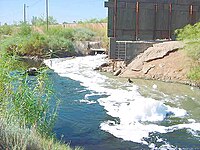
Photo from wikipedia
Metal-organic frameworks (MOFs) have potential applications in removing pollutants such as heavy metals, oils, and toxins from water. However, due to the intrinsic fragility of MOFs and their fine powder… Click to show full abstract
Metal-organic frameworks (MOFs) have potential applications in removing pollutants such as heavy metals, oils, and toxins from water. However, due to the intrinsic fragility of MOFs and their fine powder form, there are still technical barriers to their practical application such as blockage of pipes, difficulty in recovery, and potential environmental toxicity. Therefore, attention has focused on approaches to convert nanocrystalline MOFs into macroscopic materials to overcome these limitations. Recently, strategies for shaping MOFs into beads (0D), nanofibers (1D), membranes (2D), and gels/sponges (3D) with macrostructures are developed including direct mixing, in situ growth, or deposition of MOFs with polymers, cotton, foams or other porous substrates. In this review, successful strategies for the fabrication of macroscopic materials from MOFs and their applications in removing pollutants from water including adsorption, separation, and advanced oxidation processes, are discussed. The relationship between the macroscopic performance and the microstructure of materials, and how the range of 0D to 3D macroscopic materials can be used for water treatment are also outlined.
Journal Title: Small
Year Published: 2021
Link to full text (if available)
Share on Social Media: Sign Up to like & get
recommendations!